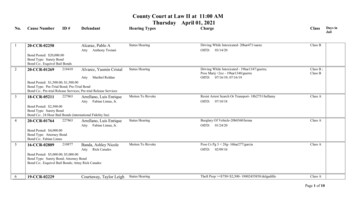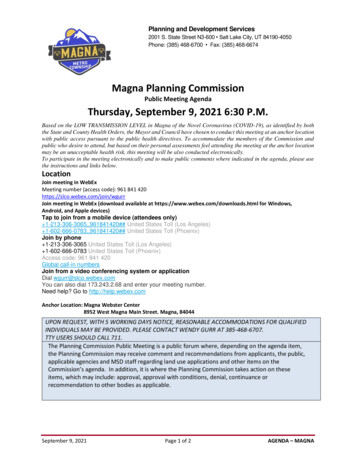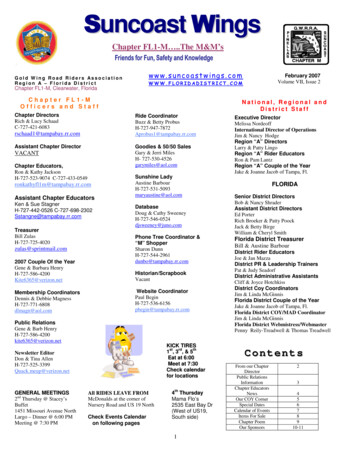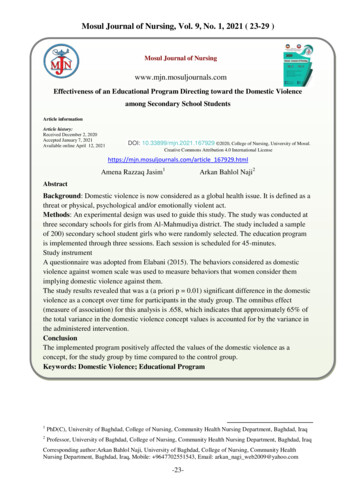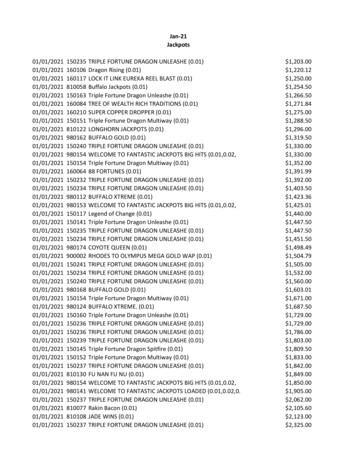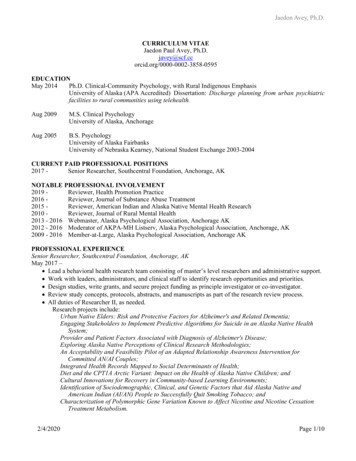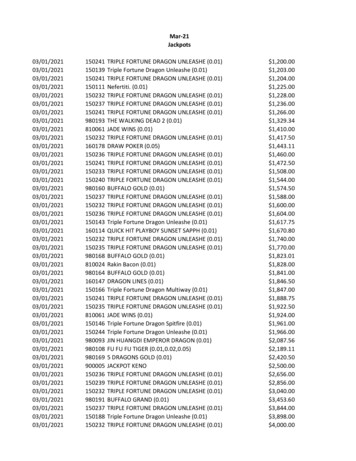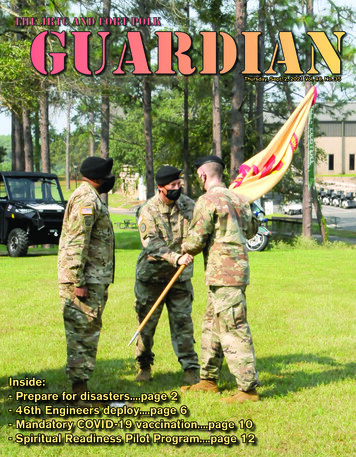
Transcription
Thursday, Sept. 2, 2021 Vol. 48. No. 35Inside:- Prepare for disasters.page 2- 46th Engineers deploy.page 6- Mandatory COVID-19 vaccination.page 10- Spiritual Readiness Pilot Program.page 12
GuardianEditorial StaffBrig. Gen. David S. DoyleJoint Readiness Training Centerand Fort PolkCommanding GeneralCol. Samuel P. Smith Jr.Garrison CommanderPublic Affairs and CommunicationsKavanaugh BreazealeKim ReischlingChuck CannonKeith HouinAngie ThorneJeff EnglandEditorial OfficesBuilding 4919, Magnolia StreetFort Polk, LA 71459-5060Voice (337) 531-4033Fax (337) rt Polk Homepagehome.army.mil/polk/Please see Prepare, page 3Cover Photo: Command Sgt. Maj. Christopher M. Ausbun, hands the colors to FortPolk Garrison Commander, Col. Samuel P. Smith Jr. during a Relinquishment of Responsibilityceremony held Sept. 2 at Fort Polk’s Warrior Field. Turn to page 5 for a story and additionalphoto. (Photo credit: Chuck Cannon, Public Affairs and Communication)2The Guardian, is an authorizedpublication for members of the U.S.Army. Contents of the Guardian arenot necessarily official views of, orendorsed by, the U.S. Government,Department of Defense, Departmentof the Army or Fort Polk.The Guardian is publishedby the Public Affairs Office, JointReadiness Training Center and FortPolk.The Guardian can be found onthe JRTC and Fort Polk web siteat home.army.mil.polk and theJRTC and Fort Polk Facebook pageat @JRTCandFortPolk/. Guardianarchives can also be found on theJRTC and Fort Polk website.Links to the Guardian are alsoincluded in all-users emails togovernment email users and byrequest to non-military units. To beincluded on all-users messages emailkimberly.k.reischling.civ@mail.mil.All editorial content of the Guardianis prepared, edited, provided andapproved by the Public Affairs Office,Joint Readiness Training Center andFort Polk.For more information on FortPolk units and happenings visitthe following Facebook pages:@JRTCOperationsGrp, @BayneJonesACH or @fortpolkmwr.
PrepareContinued from page 2BriefsSuper sign-upThe Fort Polk Spouses’ and Community Club hosts its annual super signup event Sept. 11 from noon-3 p.m.Join them at the Family ReadinessCenter, bldg 924, 7960 Mississippi Ave.,to kick off the club’s 2021-2022 activities. Registration is not required.Additional doseBayne-Jones Army Community Hos-pital understands that Fort Polk’s immunocompromised population is especially vulnerable to prolonged illness fromCOVID-19.BJACH is now offering an additionaldose of the vaccine for moderately to severely immunocompromised beneficiaries in accordance with Centers for Disease Control and Prevention Guidelines.If you answer yes to any of the followingquestions you may qualify for a thirdCOVID-19 vaccine shot at this time: Have you been receiving active can-3cer treatment for tumors or cancers of theblood? Have you received an organ transplantand are taking medicine to suppress theimmune system? Have you received a stem cell transplant within the last two years or are takingmedicine to suppress the immune system? Do you have moderate or severe primary immunodeficiency (such as DiGeorgesyndrome, Wiskott-Aldrich syndrome)? Do you have advanced or untreatedPlease see Briefs, page 8
Alaska National Guard Soldier reflects on her 9/11 experienceBy EDWARD EAGERTONAlaska National GuardMaster Sgt. Melissa Branch, Alaska Army NationalGuard state religious affairs noncommissioned officer,poses for a photo at the Alaska National Guard Armoryon Joint Base Elmendorf-Richardson, Alaska, Aug. 26.Branch, who was serving in the Marine Corps during9/11, was stationed at the Navy Annex building next tothe Pentagon in Washington and was there when theAmerican Airlines Flight 77 struck the Pentagon duringthe terrorist attack that sparked a 20-year-long war.EDWARD EAGERTON/ GUARDIANThe 26,000 military and civilians working at the Pentagon on Sept. 11, 2001 had “no anticipation that anythingwould happen” when at 9:37 a.m. Eastern time five al-Qaeda-affiliated hijackers deliberately crashed AmericanAirlines Flight 77 into the western side of the Pentagon.tween the building we just left and ArlingtonNational Cemetery. We look in front of us atthe Pentagon, and all we see is a gray cloud ofsmoke.”When many people think of first responders,firefighters, police and paramedics come tomind. However, in times of crisis, often overlooked first responders are the spiritual practitioners who respond to console and comfortpeople who experience trauma. Branch saidthey immediately got to work.“We started first by locating our fellowworkers,” she said, “and then we walkedaround the parking lot (where everyone elsehad gathered) for hours making sure that people were OK. At noon, we went into 24-hourpastoral support, and within minutes, we had40 chaplains and 10 religious affairs personnelon standby.”Branch said the day was so busy she didn’thave time to slow down and take in everythingthat had happened. It wasn’t until that nightthat the effects of the day started to wear onher.“By the time I got home, I couldn’t sleep,”she reflected. “Every little noise woke me up.4U.S. ARMY PHOTOJOINT BASE ELMENDORF-RICHARDSON, Alaska — September 11 marks not onlythe 20th anniversary of the terrorist attacks thatday in 2001, but it also comes on the cusp of theUnited States pulling out of Afghanistan. Forone Alaska Army National Guard Soldier whowas near the Pentagon that day, it is a time toreflect.Master Sgt. Melissa Branch, the Alaska ArmyNational Guard state religious affairs noncommissioned officer, was in the Marine Corps atthe time, working as a chaplain’s assistant forthe 14th Chaplain of the Marine Corps.“I arrived early to work that day,” she said.“It was Chaplain Diana Meehan’s first dayworking for us. We were doing our morningmeeting, and they wanted me to show heraround the Pentagon.”The Navy Annex building where Branchworked, which was demolished in 2013, inpart to make space for the expansion of Arlington National Cemetery, overlooked thePentagon. The new commander had steppedout of the meeting there. When she returned,she informed Branch the World Trade Centerhad been hit by a commercial airline.Before Branch could escort Meehan to thePentagon, they had to stop by the security office at the Navy Annex building for the necessary paperwork. At that point, they didn’thave reason to believe a threat was imminent,though on the way, she said she saw a friendwho was on the SWAT team heading out.“We walked down the first corridor to thefirst office, and security said we were at threatcondition normal,” said Branch. “I waved tomy friend on the SWAT team. I didn’t thinkanything about it, but they were leaving thecompound.”After leaving the security office, Branch saidtheir next stop was the health services office.She never made it to that stop.“We walked halfway down the hall to healthservices, and that’s when the plane went overour heads,” she explained.At 9:37 a.m., American Airlines Flight 77flew over the Navy Annex and crashed intothe side of the Pentagon, killing all 64 onboardand 125 people in the building.“The Navy Annex (wasn’t) a small building,” said Branch, “and it shook it like anearthquake. We walk out into the hallway, andI saw security running towards their office,I took three more steps, and the emergencyalarm goes off above my head.”From that point, it was fight or flight.“We take off running to get out of the building,” she continued. “We didn’t know whatwas going on, but we knew we needed to getout of the building. We got out of the annex,went down a flight of stairs, across the street,and now we’re standing in the median be-I heard car alarms, I heard doors opening, Iheard taxis driving by, I heard everything. Thesilence just got loud around me the whole timeI was home.”She continued to be busy for many days,working at least 12 hours a day. She workedat a temporary crisis center set up at a nearby hotel, and eventually returned to the NavyAnnex to answer the phone lines. Three dayslater, she said, they observed a National Dayof Prayer.After the events of 9/11, Branch left Washington to take other assignments with the Marine Corps. In 2007, she left the Marines andenlisted in the Arizona National Guard in 2008before transferring to the Alaska Army National Guard later that year.Branch continues to work as a spiritual adviser for fellow Soldiers. She says her experience that day in Washington 20 years ago gaveher a deeper insight into how she views life.“My time in D.C. opened my eyes to the factthat life is too short to take it for granted,” shesaid. “I plan my life as if I’m going to live to150, but I live as though I’m going to die tomorrow.”
Fort Polk bids farewell to Ausbun at Relinquishment of Responsibility ceremonyBy CHUCK CANNONPublic Affairs and Communication5CHUCK CANNON/ GUARDIANFORT POLK, La. — Command Sgt. Maj.Christopher Ausbun relinquished his role asgarrison command sergeant major during aRelinquishment of Responsibility ceremonySept. 2 on Fort Polk’s Warrior Field.Col. Samuel P. Smith Jr., commander, U.S.Army Garrison Fort Polk, addressed the distinguished guests, friends, fellow Soldiers andFamily members who attended the morning’sceremony.“It’s a true honor to speak about one of thebest command sergeants major I’ve had theprivilege of working with,” Smith said. “Acommand sergeant major lives and breathesthe Army’s highest priority: People first. Noone does that better than Command SergeantMajor Ausbun.”Smith said Ausbun, who is retiring after a23-year Army career, has been the “eyes andears across the installation,” for three garrisoncommanders, and served as the focal point between such installation partners as the Armyand Air Force Exchange Service, Defense Commissary Agency, International Hotel Groupand Corvias.“Command Sergeant Major Ausbun advocated on behalf of our installation customersand ensured our partners provided the qualityservice our Soldiers, Family members and retirees deserve,” Smith said.The Garrison Commander said Ausbunwould likely say he had little to do with thenumerous Quality of Life improvements madeduring his tenure.“We all know differently,” Smith said. “Hisdedication and commitment to the Quality ofLife on Fort Polk and his service as the righthand man to the garrison commander hashelped bring forth a better quality of life forboth today’s — and tomorrow’s — Soldiersand Families.”Smith also spoke of Ausbun’s leadershipduring 2020’s hurricanes Laura and Delta, tornadoes and the ice storm of 2021.“He (Ausbun) implemented necessary stepsduring the situation, minimizing damages toinfrastructure and protecting lives,” Smithsaid. “He provided situational awareness,sound guidance and planning for subsequentrecovery operations to the Garrison Commander and Senior Commander. CSM Ausbun’s leadership directly resulted in the Garrison suffering no loss of life or serious injuries.”Putting people first, teaching, coaching andmentoring are all characteristics Ausbun exemplified as a command sergeant major, Smithsaid.“But I think most people could sum it up intwo sentences,” Smith said. “Command Sergeant Major cares. Command Sergeant Majorexecutes. And by that, I mean that CommandSergeant Major (Ausbun) has the gift of enabling Soldiers and Family members to feelbetter just by being in the same room.”Smith recognized the support provided byAusbun’s Family: Spouse Jennifer and children Alyssa, Jordan, Anthony and Ariana.“There have been two constants in yourArmy journey,” Smith said. “The love andsupport of your Family, and your dedication tothe thousands of Soldiers and Families whoselives you have touched.”Smith reminded Ausbun of something heheard the command sergeant major say manytimes.“Now I’m going to say it to you: Once you’rea Soldier, you’re a Soldier for life,” Smith said.“None of us at Fort Polk are going to let youforget that.”Smith closed by quoting Retired Army Gen.Colin Powell who once asked, “What could bemore important than equipping the next generation with the character they need to becomesuccessful?”Command Sergeant Major (Ausbun), youhave answered that question with your actionsand have left the Army and Fort Polk in a better place,” Smith said.Ausbun said it was an honor to serve as garrison command sergeant major for the past 30months.“We have all had some great — and verychallenging — times,” he said. “But all in allthis is truly a special place to be stationed.”He thanked those responsible for having thetrust and confidence in his abilities to fill therole as garrison command sergeant major, andfor their guidance and assistance when needed. He also thanked area community leadersfor what they do for the Soldiers and Familiesassigned to Fort Polk.“The care and compassion of the people inthis area is the reason why Jennifer and I choseto retire here,” he said. “It is truly special.”Ausbun then thanked garrison directoratesand teammates for their care, determinationand initiative shown on a daily basis, alongwith the installation’s major support commandteams, the Better Opportunities for Single Soldiers team, the Command Suite team and hisgarrison commanders.“Your efforts have provided enduring support to the Soldiers and Families assigned toFort Polk, even when challenged by two majorhurricanes, multiple tornadoes, an ice storm,and a pandemic,” he said. “Your workload hasdoubled based on the Joint Readiness TrainingCenter and Fort Polk’s selection as a Quality ofLife installation. You have accepted this challenge because you are dedicated to the Soldiersand Families assigned here.”He closed by thanking his spouse, Jennifer,for their 21 years together and her support, aswell as his children.“Thank you for being a shining example ofCommand Sgt. Maj. Christopher Ausbun speaks to the audience in attendance at his Relinquishment of Responsibilityceremony held Sept. 2.resilience,” he said.Ausbun a native of Colorado Springs, Colorado, enlisted in the United States Army inNovember 1998. He has held the positionsof Bradley Fighting Vehicle Driver/Gunner,Bradley Fighting Vehicle Commander, DrillSergeant, Section Sergeant, Scout Platoon Sergeant, First Sergeant, Operations Sergeant Major, Battalion and Brigade Command SergeantMajor.He is a graduate of the Primary LeadershipDevelopment Course, Basic and Advance Noncommissioned Officer Course and the UnitedStates Army Sergeants Major Academy. Ausbun also holds an Associate Degree in AppliedScience from Central Texas College, a Bachelor’s degree in Science, and a Master’s degreein Criminal Justice through Excelsior College.His awards and decorations include: Bronzestar with “v” device, Bronze Star, Meritorious Service Medal (4OLC), Army Commendation Medal (3OLC), Army AchievementMedal (4 OCL), Army Good Conduct Medal(5th award), National Defense Service Medal,Global War on Terrorism Service Medal, GlobalWar on Terrorism Expeditionary Medal, IraqiCampaign Medal, NCOES ribbon (number 4)Military Outstanding Volunteer medal, Armyservice ribbon, overseas ribbon.Ausbun was awarded the Drill SergeantIdentification Badge, Air Assault Badge, Basic Parachutist Badge, Army Drivers Badge(Track), Combat Action Badge, Gold German Proficiency Badge, Order of St. George(Bronze), and Sergeant Audie Murphy ClubMember.
46th Engineer Battalion Soldiers deploy to support Hurricane Ida operations46th ENG BN46th ENGINEER BATTALION/FORT POLKFORT POLK, La. — The 46th Engineer Battalion, first U.S. Army active duty hurricane response forces, deployed from Joint ReadinessTraining Center and Fort Polk Aug. 31 to support Hurricane Ida response operations. Thebattalion will conduct debris removal alongemergency routes in southeastern Louisianain coordination with Louisiana state and localauthorities, and the 225th Engineer Brigade,Louisiana Army National Guard. The 46th mobilized more than 150 Soldiers and 51 pieces ofequipment in 48 hours. Their ability to assemble and deploy is a testament to the ongoingcooperation between civil and military forcesacross the total Army.6
BJACH tests capabilities during installation full scale exerciseBy JEAN CLAVETTE GRAVESBJACH PAOJEAN CLAVETTE GRAVES/BJACHFORT POLK, La. — Bayne-Jones Army Community Hospital tested its capabilities during afull scale exercise at the Joint Readiness Training Center and Fort Polk Aug. 25.The exercise was designed to test hospitalfunctions and efficiencies in the aftermath ofa severe weather incident. BJACH conductsdrills on a regular basis to test facility capabilities in an emergency situation.Sgt. 1st Class Kevin Williams, respiratorytherapist and emergency department non-commissioned officer in charge, said testing the capabilities of the hospital is important for thestaff and the installation.“On the medical side of things, we knowwhat to do, how to react and how to treat patients who come through the door,” he said.“This exercise is important because everyoneneeds to know what the plan is, what to do ina crisis and how we need to work together ifthere is a real world situation.”Williams said everyone has a role to play ina crisis, training gives the hospital staff the opportunity to work the plan without being directed.“We never know when something like thiswill happen,” he said. “We need to learn howto balance our daily operations and manage anemergency.”Williams said the mass casualty plan is initiated by the hospital commander when theamount of patients coming in will overload thenormal system.“At that time we will enact our crisis operations plan,” he said. “We will bring our forcestogether from every department in the hospital. Each key and essential staff member, bothmilitary and civilian, has a role to play. Someare directed to our manpower pool and givendirections on where to go based on the needsof the organization during a crisis. Others already know what section to report to if thereis an emergency and will immediately headthere when the code is called.”Williams said if the patients come in fast,the normal intake process can be overloaded.If that happens the hospital commander is advised and the crisis operation plan is executed.Lt. Col. Daniel Cash, deputy commander forclinical services at BJACH, echoed Williams’remarks about the relevance of drills that flexthe capabilities of the hospital and staff.“We exercise our MASCAL plan to makesure we are ready to receive and dispositionpatients in a crisis,” he said. “It stresses oursystem to help us identify areas of improvement. No organization is perfect and it helps ustweak our processes if necessary. When there isa large influx of patients, we will take care ofthem here or transport them to other hospitalsin our network for higher levels of care.”Staff Sgt. Jacob Dyer, patient administrationdivision non-commissioned officer in charge,said his department is the entry and exit pointof Army medicine.“In a MASCAL situation it is the responsibility of PAD to track and identify each patient asthey arrive and depart the hospital,” he said.“We will know exactly where they are at alltimes and what their status is.”Dyer said practicing allows everyone in thehospital to prepare for emergency situations.In preparation for an airborne operation thissummer, he said his department created masscasualty folders in the event there were a largenumber of injuries.“Sometimes in a crisis situation we rely onold school methods to expedite the process toensure we are providing the best care as quickly as possible,” Dyer said. “We use these mass7casualty folders to keep track of our patientsin a paper format. Sometimes power is affected during an emergency, sometimes patientscome in unconscious or without proper identification. This process allows us to keep trackof them until we can properly identify and ensure continuity of care by documentation.”Maj. Gary Cheatwood, deputy commanderof administration, said a lot of activities takeplace behind the scenes at the hospital beyondpatient care.“Administratively, we do a lot of things tosupport our clinicians and can provide thecare needed in these situations,” he said. “Thetraining for these events is critical to make surewe have a process in place to keep patients andstaff safe. This helps us make sure we haveall the assets and resources needed for theseevents.”
disciplinary issuesSoldiers punished for disciplinary issues DES dispose of vehiclesOSJAFORT POLK, La. — The preamble to theManual for Courts-Martial states, “The purpose of military law is to promote justice, to assist in maintaining good order and disciplinein the armed forces, to promote efficiency andeffectiveness in the military establishment, andthereby strengthen the national security of theUnited States.” At the Joint Readiness TrainingCenter and Fort Polk, the commanding generaland subordinate commanders take good orderand discipline seriously.Across Fort Polk, the following disciplinaryissues continue to be prevalent: Driving underthe influence of alcohol, wrongful use/possession of controlled substances, fraternization,sexual assault and underage drinking. Beloware recent examples of adverse legal actions forunits within the Fort Polk jurisdiction. A staff sergeant, assigned to the 3rd Brigade Combat Team, 10th Mountain Division,was issued a General Officer Memorandum ofReprimand for engaging in an intimate relationship with a junior enlisted Soldier, in violation of Article 92, Uniform Code of MilitaryJustice. A private, assigned to 46th Engineer Battalion, was punished under Article 15 forwrongfully possessing cigarillo wrappersand a pipe and for wrongfully using a Schedule I substance, in violation of Article 92 andArticle 112a, Uniform Code of Military Justice. The Soldier was sentenced to a reduction to private (E-1); forfeiture of 446 pay;extra duty for 45 days and restriction for 45days, suspended. A private, assigned to 46th Engineer Battalion, was separated under Chapter 14-12c(Commission of a Serious Offense) for resisting arrest and assaulting a police officer. TheSoldier was issued a general under honorable conditions characterization of service.Generally, this characterization of service results in the loss of a service member’s educational benefits. A private, assigned to Operations Group,was separated under Chapter 14-12c(2) (Misconduct-Abuse of Illegal Drugs) for being inpossession of marijuana. The Soldier was issued a general under honorable conditionscharacterization of service. Generally, thischaracterization of service results in the lossof a service member’s educational benefits.BriefsContinued from page 3HIV infection? Are you currently on an active treatment with high-dose corticosteroids orother drugs that may suppress your immune response? If you would like to getan additional dose of the COVID-19 vaccine, call 531.3011 for a telehealth appointment to discuss whether getting an additional dose is appropriate for you.quick, easy and hassle free: Call in a prescription refill to 531.3785. Select Option2 or request a refill at tricareonline.com.Prescriptions will be available after noonthe next business day. For first time users, bring your Department of Defense IDcard and prescription number to registerwith the Script Center machine.Once registered, the Script Center canbe used 24/7 to pick up refill prescrip24/7 prescription centerThe Script Center machine located at tions with ID card, username and passBayne-Jones Army Community Hospi- word or fingerprint login. For more infortal’s Entrance A, is available 24/7 for mation visit https://bayne-jones.tricare.non-refrigerated prescription refills. It’s mil/Health-Services/Pharmacy8The Directorate of Emergency ServicesTraffic Division will release the followingvehicles to the Directorate of Family Morale, Welfare and Recreation if they remainunclaimed. Vehicles are listed with the lastfour numbers of their VIN number. If oneof these vehicles belongs to you, pleasecontact the Fort Polk Police Traffic Sectionat 531.1806/6675/2677. You may also report in person to the traffic division at 166822nd St., bldg 2396. Office hours are Monday through Thursday from 8 a.m.-4 hevroletHyundaiKIACruz4DSDTahoeK2500AvalonPark 2201314195954437309771875647690634
Dedicated to safe training:training Evolution of COVID defense at JRTCBy Maj. JENNIFER DYRCZOperations GroupA Soldier washes his hands during Rotation 21-09 at the Joint Readiness Training Center at Fort Polk, Louisiana.Maj. JENNIFER DYRCZ/OPERATIONS GROUPFORT POLK, LA — The Joint ReadinessTraining Center and Fort Polk is preparingfor its 12th brigade formation, the 3rd BrigadeCombat Team, 101st Airborne Division (AirAssault), to join them through the month ofSeptember for training Rotation 21-10. Alongwith traditional preparation such as scenariodevelopment, equipment repair and doctrinereview comes the added layer of COVID-19safety.When the nation-wide lockdowns began inMarch of 2020, the leadership and health officials at JRTC had about 90 days to implementmeasures which would protect the 4th Security Force Assistance Brigade from Fort Carson, Colorado. The northern part of Fort Polk,typically where training rotations are housed,immediately turned into “the North Fort Safety Bubble.” All observer, coach, trainers andsupport staff had to present credentials to beallowed entry and only after they had passeda COVID test for that month’s rotation; measures allowing for stringent mitigation of apossible outbreak.Once in “the Bubble,” OCTs had to havetemperature and health screening checks eachtime they went into and out of “The Box,”where the bulk of the brigades train, as wellas the standard observance of social distancingand masking.“These protective postures enabled us tomaintain training and Army readiness, allwhile making sure the training formation, Soldiers and Families of Fort Polk stayed safe,”said JRTC and Fort Polk Commanding General, Brig. Gen. David S. Doyle.With each new rotation came evaluations ofhow to best maintain realistic training during aglobal pandemic. Once the COVID-19 vaccinewas given emergency authorization for use,the JRTC community was encouraged to getvaccinated. By the summer of 2021 several brigades were authorized to train without masks.However, with the rise of the Delta variant,JRTC had to reexamine measures and duringthis August’s Rotation 21-09, the Soldiers ofthe 54th Security Force Assistance Brigadefrom the Indiana National Guard, were issuedwristbands denoting vaccination status. Thesewere used to assist the OCTs to be more precise in measuring risk in contact tracing to helpkeep more people in the training scenario.“From the beginning, over a year ago, JRTCand Fort Polk has implemented safety protocols based off of Centers for Disease Controland Department of Defense guidance. Witheach new brigade’s rotation, the team here rigorously reviews the training environment inregards to COVID mitigation, and they flex asnecessary. These wristbands are just one moretool keeping our training areas, Soldiers, Fami-Soldiers move throughout their motor pool during Rotation 21-09 at the Joint Readiness Training Center at FortPolk, Louisiana.lies and support staff safe,” said JRTC and FortPolk Operations Group Commander, Col. Andrew Saslav.Even with the U.S. Secretary of Defense’smandate for Soldiers to receive the vaccine“immediately,” JRTC expects to still use its toolof “wristbanding” for 3/101st Div (Abn).With each rotation and new advance in safety, JRTC leadership will assess the most appro-9priate measures needed to keep formations,trainers, Families and the local communitysafe.This, in turn, allows the thousands of Soldiers who come to JRTC and Fort Polk eachmonth the ability to feel protected while training to conduct large scale combat operations,a mission which enables the Army to supportglobal deployment and readiness needs.
SJA answers questions about mandatory COVID vaccinationsPUBLIC AFFAIRS AND COMMUNICATIONFORT POLK, La. — Secretary of DefenseLloyd J. Austin III issued a memorandum forMandatory Coronavirus Disease 2019 Vaccination of Department of Defense Service Members Aug. 24.The memo directs the Secretaries of theMilitary Departments to immediately beginfull vaccination of all members of the ArmedForces under DoD authority on active duty orin the Ready Reserve, including the NationalGuard, who are not fully vaccinated againstCOVID-19.Mandatory vaccination against COVID-19will only use COVID-19 vaccines that receivefull licensure from the Food and Drug Administration (FDA), in accordance with FDA-approved labeling and guidance. Service members voluntarily immunized with a COVID-19vaccine under FDA Emergency Use Authorization or World Health Organization EmergencyUse Listing in accordance with applicable doserequirements prior to, or after, the establishment of this policy are considered fully vaccinated.What the Centers for Disease Control recommends people know about the vaccine: COVID-19 vaccines are effective at helpingprotect against severe disease and death fromvariants of the virus that causes COVID-19 currently circulating, including the Delta variant. If you are fully vaccinated you can resumemany activities that you did before the pandemic, but you should wear a mask indoorsin public if you are in an area of substantialor high transmission to maximize protectionfrom the Delta variant and possibly spreadingit to others. Yo
Sep 02, 2021 · working for us. We were doing our morning . meeting, and they wanted me to show her around the Pentagon.” The Navy Annex building where Branch . worked, which was demolished in 2013, in . part to make space for the expansion of Ar-lington National Cemetery, overlooked the Pentagon. The new commande

